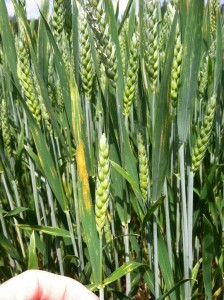Due to the recent rain, scab risk is increasing in portions of Virginia, especially on the Eastern Shore and coastal areas. The scab risk assessment tool can be found at http://www.wheatscab.psu.edu. Many fields are at or near flowering. In most areas, moderately resistant (MR) varieties are in the low to medium scab risk category, but keep in mind that many acres are still planted to moderately susceptible (MS) or susceptible (S) varieties such as Shirley. In the eastern portions of the state, scab risk is projected to be high for susceptible varieties over the next week, and it will likely be necessary to work in fungicide applications between rain events. Fungicides targeting scab should be applied within 5-6 days of flowering (50% of main tillers starting to flower from the center of the head). Do NOT apply a strobilurin or fungicide pre-mix containing a strobilurin after flag leaf emergence (Feekes 9) since this can increase DON contamination in the grain. Prosaro, Caramba, and Proline are the most effective products for reducing scab and DON contamination. These fungicides will also control foliar diseases such as leaf blotch, stripe and leaf rust, and powdery mildew. Stripe rust has been observed on susceptible wheat cultivars in some fields for several weeks now, but levels remained low due to dry conditions. The recent rain and humid conditions have resulted in spread of the disease in some areas. Similar conditions are forecasted over the next week and the disease has the potential to spread rapidly, so growers should scout their fields immediately to determine if stripe rust is present.

